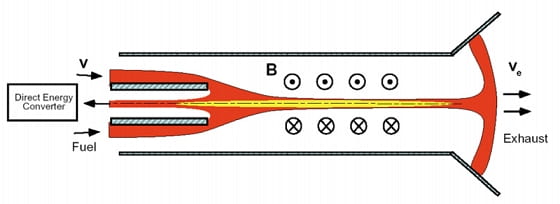The Fourth State of Matter
Plasma is the fourth state of matter. It is essentially a very hot, ionized gas. It is what makes up the sun and most of the universe. Plasma is so hot (millions of Kelvin) that it cannot be contained by physically. Instead, magnetic confinement is frequently used. One such method of confinement, the method used on ZaP, is called a Z-pinch.
Applications of Plasmas
Fusion
Nuclear fusion is the process of recombining nuclei to form different nuclei and release vast amounts of energy. This is the process that powers the sun. If we can harness it, nuclear fusion has the potential to provide us with nearly limitless amounts of clean energy. As such, it is often described as the Holy Grail of plasma physics.
There are three conditions necessary for nuclear fusion: high temperatures ( to about 107 K), high density, and prolonged stability. The high temperature requirement places us in the regime of plasmas. While experiments have attained these high temperatures, the primary difficulty is in achieving a sufficiently high combination of density and stability.
Propulsion in Space
Plasmas also have applications in the propulsion of spacecraft. The ZaP experiment is particularly well-suited to this application. Since it requires no externally applied magnetic field, the weight and size requirements of a such a vehicle are drastically lower than other plasma configurations would require. A diagram of a possible ZaP thruster design is shown in Figure 1. Such a thruster could achieve an Isp of 1,000,000 s, and a thrust on the order of 105 N (similar to a Boeing 747). You can read more about the ZaP thruster in the following paper: Advanced Space Propulsion Based on the Flow-Stabilized Z-Pinch Fusion Concept (AIAA 2006-4805).

Schematic of a possible ZaP thruster design. This is very similar to the ZaP experimental setup, except that the inner electrode is hollow and the end wall flares out. Most of it flows out the back (to the right), propelling the space craft forward (to the left). Some flows back into the inner electrode to be used to provide power to the spacecraft’s control systems. The thruster could operate in either a steady-state or long-pulse mode.
Other Applications
Plasma processing
Photolithography
Understanding astrophysical phenomena
Hypersonic flight

A fast-framing, black-and-white camera takes photos of the plasma during a pulse. In the two cases shown, the pictures were taken at 200 ns increments through a 5 cm hole in the outer electrode. The flow is to the left. The times listed are time after the experiment was triggered. The upper strip of photos shows a stable pinch. The lower strip shows the formation and propagation of an unstable kink, which disrupts the flow. The upper and lower sets of images were taken during two different plasma pulses.

